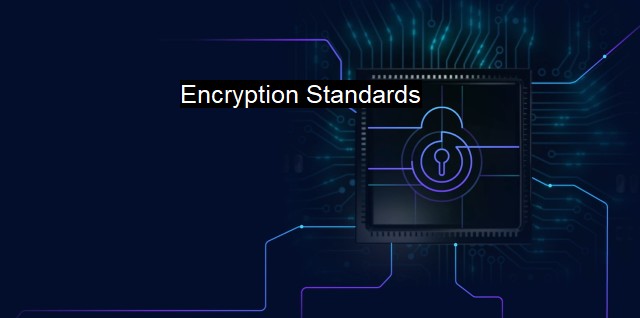What are Encryption Standards?
Encryption Standards: The Essential Component for Cybersecurity and Antivirus Software
In a world where cybersecurity often means the difference between operating a successful, secure business and falling foul to a potentially catastrophic data breach, the term "Encryption Standards" holds significant meaning. An understanding of these encryption standards is crucial to understanding the foundations of cybersecurity and antivirus defenses.Simply put, encryption standards refer to the technologies, methodologies, or protocols that dictate how data encryption should occur. Encryption, in this context, refers to the process through which data or information is altered, changing it from a readable format (plaintext) to an unreadable format (ciphertext), thus making it inaccessible to unauthorized parties.
Several encryption standards existing today have significantly contributed to various cybersecurity applications, including antivirus software. They uphold the critical cybersecurity principles of confidentiality, integrity, and availability of data by preventing unauthorized access and ensuring secure data transmission.
Perhaps the most well-known encryption standard is the Advanced Encryption Standard (AES). The US Government's National Institute of Standards and Technology (NIST) approved it in 2001 after concluding a five-year process of rigorous testing and evaluation. AES replaced the Data Encryption Standard (DES), developed in the 1970s, which was found to have several vulnerabilities that opened doors for cyber-attacks. SEO following, It’s widely considered the gold standard of symmetric encryption - meaning the same key is used both to encrypt and decrypt the data - and is used globally in protecting sensitive data across various sectors, emphasizing its efficacy and cybersecurity significance.
Other notable encryption standards include the RSA (Rivest-Shamir-Adleman) which is based on the principle of a public and a private key. In this system, the public key is used to encrypt data while the private key, held secretly, is used to decrypt it. This mechanism facilitates secure data transfer over networks, even when the networks themselves might be insecure, reinforcing the cybersecurity framework.
Transport Layer Security (TLS), and its predecessor, Secure Sockets Layer (SSL), are cryptographic protocols that provide secure connections over a network, such as between a web browser and a server. They have become integral mechanisms for ensuring cybersecurity, especially within e-commerce and internet banking, allowing confidential user data to be transmitted securely over the internet.
Hashing algorithms, such as Secure Hash Algorithm (SHA) and Message Digest Algorithm-5 (MD5), are vital in detecting any unauthorized changes to data. Though not strictly an encryption process, these algorithms convert data into a fixed-length series of characters known as a hash that represents the original information. If any part of the original data changes, the hash produced changes too, indicating potential tampering and maintaining the integrity of data in the cybersecurity context.
Intrinsically, these encryption standards fortify cybersecurity, forming the basis of most antivirus software, and it's not hard to see why once it's understood how encryptions work. When a user protects their computer with antivirus software, any data a malicious party might extract in the event of a breach will be encrypted. it becomes meaningless garble without the decryption key which only the authorized party holds, certainly obstructing the exploits of the shady cybercriminal ensuring the authorized user's confidential information remains that way.
A proper understanding of encryption standards does not only provide insight into the cyber world's protection mechanisms but also serves as a reminder of their importance. As cybercrime continues to evolve and exploit technologies, so do encryption standards. They have now become an integral part of a world where virtual is the new vulnerable. Developing effective, efficient, and robust encryption standards continues to be an ongoing pursuit for those invested in cybersecurity and ensuring that antivirus software always stands a step ahead of ill-intended cybercriminals.

Encryption Standards FAQs
What are encryption standards?
Encryption standards refer to a set of rules, protocols, and procedures that govern the secure transmission of data between two endpoints. These standards ensure that the information transmitted is protected from unauthorized access, ensuring that data remains secure and confidential.Why are encryption standards important?
Encryption standards are crucial in cybersecurity and antivirus because they protect sensitive data from cybercriminals who attempt to compromise it. These standards ensure that only authorized parties can access the encrypted data, protecting it from theft or unauthorized modification.What are some popular encryption standards?
Some popular encryption standards include Advanced Encryption Standard (AES), Rivest-Shamir-Adleman (RSA), and Secure Hash Algorithm (SHA). AES is widely used for symmetric encryption, RSA for asymmetric encryption, and SHA for hashing.Are there any drawbacks to using encryption standards?
While encryption standards provide strong security and protection of data, they can also introduce performance issues. Encrypting and decrypting large amounts of data can be resource-intensive, leading to slower data transfer rates. Additionally, encrypted data can be difficult to access for legitimate users if they do not possess the necessary encryption keys.| | A | | | B | | | C | | | D | | | E | | | F | | | G | | | H | | | I | | | J | | | K | | | L | | | M | |
| | N | | | O | | | P | | | Q | | | R | | | S | | | T | | | U | | | V | | | W | | | X | | | Y | | | Z | |
| | 1 | | | 2 | | | 3 | | | 4 | | | 7 | | | 8 | | |||||||